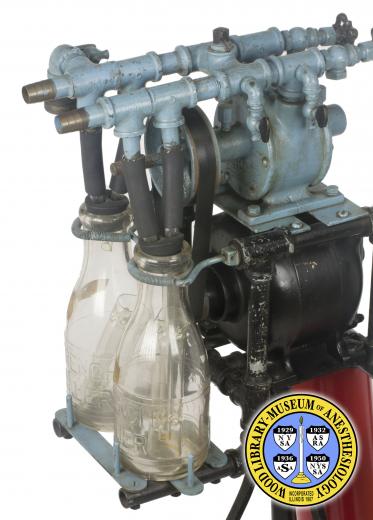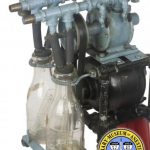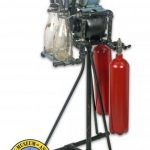Jackson CO2 Absorber
Dr. Dennis E. Jackson (1878-1980) earned a PhD in pharmacology in 1908 and a medical degree in 1913. His sensitivity to the struggles of poorer patients made him aware of the need for more affordable nitrous oxide (N2O) anesthesia, and drove his efforts to develop a carbon dioxide (CO2) absorbing anesthesia machine. Jackson knew that less N2O would be required to anesthetize a patient if the gas that the patient exhaled could be reused (in other words rebreathed) by the patient. Using less N2O meant less cost for the patient. In order for a patient to rebreathe his exhaled gas, the air and gas breathed in and out needs to be contained within a system closed off from the external environment. Also, oxygen and small amounts of N2O need to be added, and CO2 needs to be removed. Dr. Jackson first developed such a system in 1914. The apparatus pictured here was likely built some time between 1915 and early 1918. During this time period he also created a very simple CO2 absorber using a cake pan and a shower cap. Although the world was not ready for such considerable changes in anesthesia administration, others, such as Dr. Ralph Waters, eventually advanced the concepts and refined equipment until CO2 absorption and closed anesthesia systems became standard for all anesthesia machines.
Catalog Record: Jackson CO2 Absorber
Access Key: aiwx
Accession No.: 435
Title: [Dennis Jackson carbon dioxide absorption anesthesia machine.]
Author: Jackson, Dennis E. (Dennis Emerson), 1878-1980.
Title variation: Alt Title
Title: Jackson’s carbon dioxide absorption machine.
Title variation: Alt Title
Title: Dennis Jackson carbon-dioxide absorbing device.
Title variation: Alt Title
Title: Jackson apparatus with CO2 absorption.
Publisher: [1915-1918.]
Physical Descript 1 anesthesia machine ; iron, other metals, glass, rubber : 104 x 62 x 49 cm
Subject: Carbon Dioxide Absorber.
Subject: Anesthesia Machines.
Note Type: General
Notes: Descriptive title based on the WLM name for the apparatus.
Note Type: General
Notes: The date range for the possible date of manufacture is based on a statement
on page 955 of a 1955 article by Dr. Jackson, Anesthesia Equipment from 1914
to 1954 and Experiments Leading to its Development: “During the years
1915-1917 and the early part of 1918 I made up a large number of machines of
widely varying characteristics.”
Note Type: With
Notes: With three wheels which have been removed to stabilize the apparatus.
Note Type: Citation
Notes: Jackson DE. Anesthesia equipment from 1914 to 1954 and experiments leading to
its development. Anesthesiology. 1955;16(6):953-969.
Note Type: Citation
Notes: Morris LE. Carbon dioxide and anesthesia. In: Diz JC, Franco A, Bacon DR. The
History of Anesthesia. Amsterdam: Elsevier; 2002:145-155.
Note Type: Citation
Notes: Rendell-Baker L. Unsung heroes of anesthesia: Dennis E. Jackson, William B.
Neff, Robert A. Hingson. Anesth Hist Assoc Newsl. 1994;12(4):8-11.
Note Type: Physical Description
Notes: One anesthesia machine with an electric motor and two large milk bottles held
aloft by a tripod-like stand attached to a T-shaped base; The base, stand,
and electric motor are covered in black paint; A pump above the motor, and
metal tubing, are covered in a sky blue paint; Two glass milk bottles are
each embossed with “French Bauer” on one side and “Milk for Health” on the
other; One of the bottles has a paper label marked H2SO4″; The paper label on
the other bottle is torn and only “OH” remains; The bottles are approx. 25.5
cm in height; Descending into each milk bottle is a cylindrical glass tube,
one of which is broken; An electrical cord, approx. 86 cm in length, exits
the electric motor; The cord is covered in a black fabric; Two gas cylinder
yokes are located on the machine, on the side opposite the glass bottles.
Note Type: Reproduction
Notes: Photographed by Mr. William Lyle, July 28, 2010; In order to present an
image of the apparatus in the best state possible, it was photographed with
generic gas tanks from the Parts Collection.
Note Type: Historical
Notes: Dr. Dennis E. Jackson (1878-1980) earned a PhD in pharmacology in 1908 and a
medical degree in 1913. His strong science background may partially explain
his ability to see solutions to clinical problems long before most of his
physician colleagues were receptive to his ideas. Jackson’s sensitivity to
the struggles of poorer patients made him aware of the need for more
affordable nitrous oxide (N2O) anesthesia, and motivated his work to develop
a carbon dioxide absorbing anesthesia machine. Jackson knew that less N2O
would be required to anesthetize a patient if the gas that the patient
exhaled could be reused (in other words rebreathed) by the patient. Using
less N2O meant less cost for the patient. In order for a patient to rebreathe
his exhaled gas, the air and gas breathed in and out needs to be contained
within a system sealed or closed off from the external environment, oxygen
and small amounts of N2O need to be added, and CO2 needs to be removed.
Jackson developed his first closed system with the ability to absorb CO2 in
1914 (Jackson, 1955). The apparatus described here was likely built by
Jackson some time between 1915 and early 1918. During this time period he
also created a very simple CO2 absorber using a cake pan and a shower cap.
Jackson published his method in 1915, and exhibited one of his devices at the
AMA convention in 1916 (Jackson, 1955). Although oxygen (O2) and N2O were
likely used with this machine, we cannot be certain. Jackson described
making CO2 absorbing anesthesia machines that could administer O2, N2O, ether
chloroform, ethyl chloride, and acetylene (Jackson, 1955). Although the
world was not ready for such considerable changes in anesthesia
administration, others, such as Dr. Ralph Waters, eventually advanced the
concepts and refined equipment until CO2 absorption and closed anesthesia
systems became standard for all anesthesia machines (Morris, 2002 ;
Rendell-Baker, 1994).
Note Type: Publication
Notes: Morris Lucien E. D.E. Jackson 1878-1980: a perspective. In: Atkinson RS,
Boulton TB. The History of Anaesthesia. London: Royal Society of Medicine
Services and The Parthenon Pub. Group;1989:571-574.
Note Type: Publication
Notes: Stetson JB. Dennis Emerson Jackson (1878-1980). In: Atkinson RS, Boulton TB.
The History of Anaesthesia. London: Royal Society of Medicine Services and
The Parthenon Pub. Group;1989:564-571.



